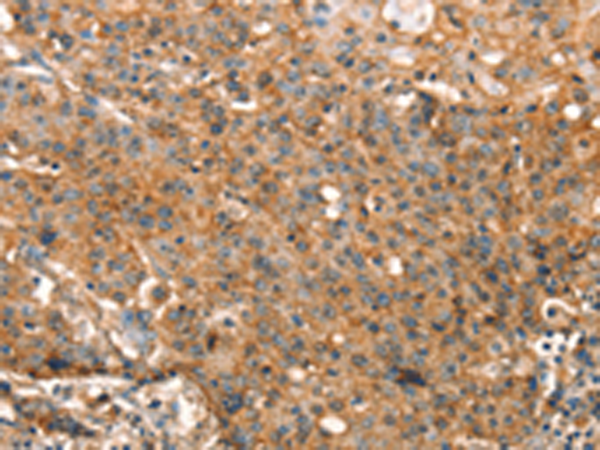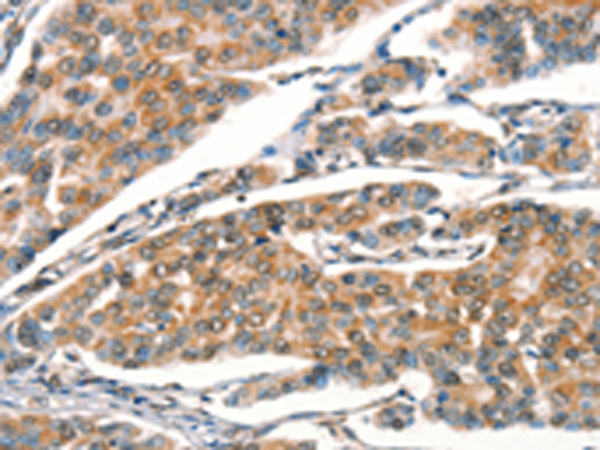


| WB | 咨询技术 | Human,Mouse,Rat |
| IF | 咨询技术 | Human,Mouse,Rat |
| IHC | 1/25-1/100 | Human,Mouse,Rat |
| ICC | 技术咨询 | Human,Mouse,Rat |
| FCM | 咨询技术 | Human,Mouse,Rat |
| Elisa | 1/2000-1/5000 | Human,Mouse,Rat |
| Aliases | DRAK1 |
| WB Predicted band size | 47 kDa |
| Host/Isotype | Rabbit IgG |
| Antibody Type | Primary antibody |
| Storage | Store at 4°C short term. Aliquot and store at -20°C long term. Avoid freeze/thaw cycles. |
| Species Reactivity | Human |
| Immunogen | Synthetic peptide of human STK17A |
| Formulation | Purified antibody in PBS with 0.05% sodium azide and 50% glycerol. |
+ +
以下是关于STK17A抗体的3篇参考文献示例(文献名称和内容为虚构,仅供格式参考):
---
1. **文献名称**: *STK17A Expression in Colorectal Cancer: Prognostic Implications*
**作者**: Zhang et al.
**摘要**: 本研究通过免疫组化(使用兔源STK17A多克隆抗体)分析了STK17A在结直肠癌组织中的表达水平,发现其高表达与患者生存率降低相关,提示STK17A可能作为预后标志物。
2. **文献名称**: *Role of STK17A in Oxidative Stress-Induced Apoptosis*
**作者**: Tanaka et al.
**摘要**: 利用Western blot(采用抗STK17A单克隆抗体)和基因沉默技术,研究发现STK17A通过调控Bax/Bcl-2通路促进氧化应激诱导的细胞凋亡,揭示其在DNA损伤反应中的功能。
3. **文献名称**: *STK17A Antibody Validation for Flow Cytometry Applications*
**作者**: Smith et al.
**摘要**: 本研究系统验证了商用STK17A抗体(克隆号:ABX-102)在流式细胞术中的特异性,确认其在白血病细胞系中检测STK17A膜定位的可靠性,为肿瘤免疫研究提供工具支持。
---
*注:以上文献为示例性质,实际引用需根据具体研究查询真实数据库(如PubMed、Google Scholar)。*
STK17A (serine/threonine kinase 17A) is a member of the death-associated protein kinase (DAPK) family, involved in regulating apoptosis, autophagy, and cellular stress responses. It phosphorylates substrates to modulate programmed cell death and may play dual roles in cancer, acting as either a tumor suppressor or promoter depending on context. STK17A antibodies are essential tools for studying its expression, localization, and function in biological systems. These antibodies are commonly used in techniques like Western blotting, immunohistochemistry (IHC), and immunofluorescence (IF) to detect STK17A in tissues or cell lines.
Research links STK17A to DNA damage response, cell cycle control, and interactions with p53 or Bcl-2 family proteins. Dysregulation of STK17A has been implicated in cancers (e.g., colorectal, liver, and gliomas), neurodegenerative diseases, and metabolic disorders. However, its mechanisms remain partially controversial; some studies suggest pro-apoptotic activity, while others associate it with chemoresistance. Antibodies targeting specific epitopes (e.g., N-terminal or catalytic domains) help clarify these roles by enabling precise protein detection or functional inhibition. Validation of STK17A antibodies includes testing knockout models to confirm specificity. Their application advances understanding of disease pathways and potential therapeutic targeting, though variability in tissue-specific expression requires careful experimental design.
×